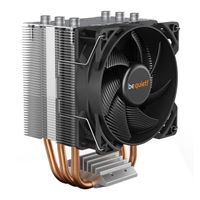Cool Off with CPU Fans and Heatsinks
Computer processors generate enormous amounts of heat - and with more processing power comes even more heat. That is why we have CPU coolers, devices that use a combination of various cooling methods to keep your CPU chilled out. Although many modern CPUs come with a cooler module, aftermarket coolers can still be a must have if your CPU does not include one, or you plan to overclock your processor past the specs your stock cooler can support.
Modern CPU cooling systems consist of these main parts:
Base Plate: The metal plate that sits at the bottom of the cooler unit, absorbing heat from the CPUs heat spreader and the thermal compound.
Heat Pipes: Metal pipes, usually made from copper, that draw heat upward from the base plate, using tiny amounts of water that are constantly evaporating and condensing.
Fins: Metal fins increase the heatsinks surface area and allow it to disperse heat much more efficiently.
Cooling Fan: A fan attached to the cooler blows air across the fins and heat pipes, significantly improving heat dissipation.
Put together, these components form the CPU coolers that sit atop many of our processors. Of course, there is also liquid cooling systems, which are popular among users who want to push their processors a little harder. Check out our full selection of all in one liquid coolers here.
Choosing a CPU Heatsink for Your Processor
What factors should you look at when you are evaluating CPU air coolers? These are some of the most important:
CPU Socket: Heatsinks are designed to fit certain Intel or AMD motherboard sockets. Make sure you know which type of CPU you have and which socket it uses.
Airflow: Generally, more airflow means more cooling power. A coolers airflow, measured in cubic feet per minute or CFM, will give you an approximate idea of how much air the fan can move.
Fan Size and Speed: These are two more specs that affect the coolers heat dissipation performance. Larger fans move more air and thus provide more cooling. A fans maximum speed, measured in RPM, can also be a factor in cooling performance, although it is worth noting that running a fan at higher RPM will be louder and can wear the fan out more quickly.
Noise Level: Some CPU fans can produce relatively high noise levels. Check the fans noise rating measured in decibels or dBA for an approximation of how loud it will be.
Form Factor: CPU coolers can be fairly large and take up a significant amount of room in your PC case, so check the dimensions carefully. Look for a low profile cooler if space is a big concern.
Shop Micro Centers lineup of coolers for great prices on high performance CPU heatsinks from the industry's biggest names, including Thermaltake, Cooler Master, Noctua, and more. Remember to grab a tube of quality thermal paste for your CPU, and check out our selection of case fans to perfect your custom air cooling solution.


